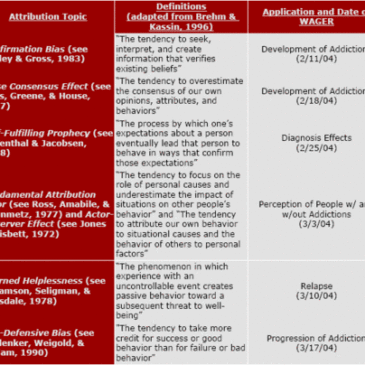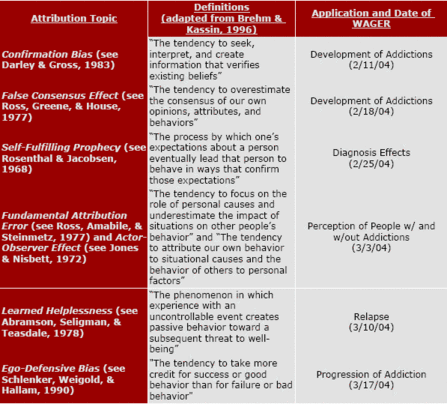Series Special Editor:Sarah E. Nelson
The Super Bowl is one of the most heavily wagered sporting events in the United States. One might explain this betting phenomenon in several ways. Perhaps the mere exposure to the hype that surrounds the Super Bowl accounts for increased betting. Or perhaps football fans are particularly vulnerable to betting on sporting events because they tend to share a common personality trait. However, personality traits and exposure rarely, if ever, entirely explain an individual’s specific behaviors. Rather, a more complete explanation of Super Bowl betting behavior requires consideration of people’s expectations about, and interpretations of, the situation and their relation to it. Individuals’ perceptions of why things happen and how those perceptions influence behavior are the subject of attribution theory.
Attribution theory suggests that a person’s attributions about the causes of a situation or behavior (i.e., his or her inferences about why that situation or behavior occurred) influence that person’s reaction to the situation or behavior (Heider, 1965; Ross & Nisbett, 1991). For example, consider how missing his first field goal attempt in the Super Bowl might have affected Patriots’ kicker Adam Vinatieri. If he had attributed the miss to a lack of skill or an inability to deal with the pressure of the game, those attributions might have affected his future performance and his game-winning field goal attempt might have turned out quite differently. Instead, according to the Boston Globe (MacMullan, 2004), Vinatieri put on longer spikes during halftime, apparently attributing his miss to the slick field conditions and changing footwear accordingly. The rest is history. Similarly, the attributions people make about why they have bet in the past, why they have won or lost, and why others bet on the Super Bowl, can influence their own gambling behavior on Super Bowl Sunday.
Attribution theory, and the mediating link it provides between situations and behavior, can inform our thinking about gambling behavior in particular and addiction in general. The next six WAGERs will focus on the contribution of attribution theory to our understanding of the course of addiction and how people recover from addictions. Each WAGER will cover one particular topic of attribution theory and its application to the progression of addiction, as displayed in Table 1.
Table 1. Attribution Topics and Applications to the Addictions.
People can make attributions of causality (i.e., judgments about why things happen) for many events, including their own or others’ behaviors and outcomes (e.g., success or failure). Hence, betting behavior on Super Bowl Sunday might result directly from people’s attributions about why their team has done well or poorly in the past or why they have won or lost bets in the past (i.e., confirmation bias). They might believe that everyone bets on Super Bowl Sunday (i.e., false consensus effect), or that because their friends think of them as a “serious football fan,” they are expected to bet (i.e., self-fulfilling prophecy). Those who do not bet or follow football might view their husbands’ and wives’ Super Bowl Sunday betting behavior as a reflection of their fanatical personalities, ignoring the influence of the hype surrounding the game (i.e., fundamental attribution error). When confronted by their upset spouses about their betting behavior, these husbands and wives might feel that they couldn’t help themselves – that the situation rendered their behavior uncontrollable, that they are never able to resist a sports betting opportunity of that magnitude, and that they likely won’t be able to restrain from similar betting in the future (i.e., learned helplessness). They also might argue that although the decision to bet was totally out of their control, they won their bet because of their skill in playing the odds (i.e., ego-defensive biases).
Attribution theory can add to our understanding of gambling disorders and other addictions by providing information about the cognitive mechanisms and processes by which situations and personal vulnerabilities can influence behavior. This WAGER series on attribution will begin next week with a study of the role of attributions in the development of gambling problems.
Comments on this article can be addressed to Sarah Nelson.
References
Abramson, L. Y., Seligman, M. E., & Teasdale, J. (1978). Learned helplessness in humans: Critique and reformulation. Journal of Abnormal Psychology, 87, 49-74.
Brehm, S. S., & Kassin, S. M. (1996). Social psychology. Boston: Houghton Mifflin Company.
Darley, J. M., & Gross, P. H. (1983). A hypothesis-confirming bias in labeling effects. Journal of Personality & Social Psychology, 44(1), 20-33.
Heider, F. (1965). The psychology of interpersonal relations. New York: Wiley.
Jones, E. E., & Nisbett, R. (1972). The actor and the observer: Divergent perceptions of causality. In E. E. Jones, D. E. Kanouse, H. H. Kelley, R. Nisbett, S. Valins & B. Weiner (Eds.), Attribution: Perceiving the causes of behavior (pp. 79-94). Morristown, NJ: General Learning Press.
MacMullan, J. (2004, February 2nd). Mr. Clutch, no doubt about it. Boston Globe.
Rosenthal, R., & Jacobsen, L. (1968). Pygmalion in the classroom: Teacher expectation and pupils’ intellectual development. New York: Holt, Rinehart and Winston.
Ross, L., Amabile, T. M., & Steinmetz, J. L. (1977). Social roles, social control, and biases in social perceptioin processes. Journal of Personality and Social Psychology, 35, 485-494.
Ross, L., Greene, D., & House, P. (1977). The false consensus phenomenon: An attributional bias in self-perception and social-perception processes. Journal of Experimental Social Psychology, 13, 279-301.
Ross, L., & Nisbett, R. (1991). The person and the situation: Perspectives of social psychology: McGraw Hill Publishers.
Schlenker, B. R., Weigold, M. F., & Hallam, J. R. (1990). Self-serving attributions in social context: Effects of self-esteem and social pressure. Journal of Personality and Social Psychology, 58, 855-863.





